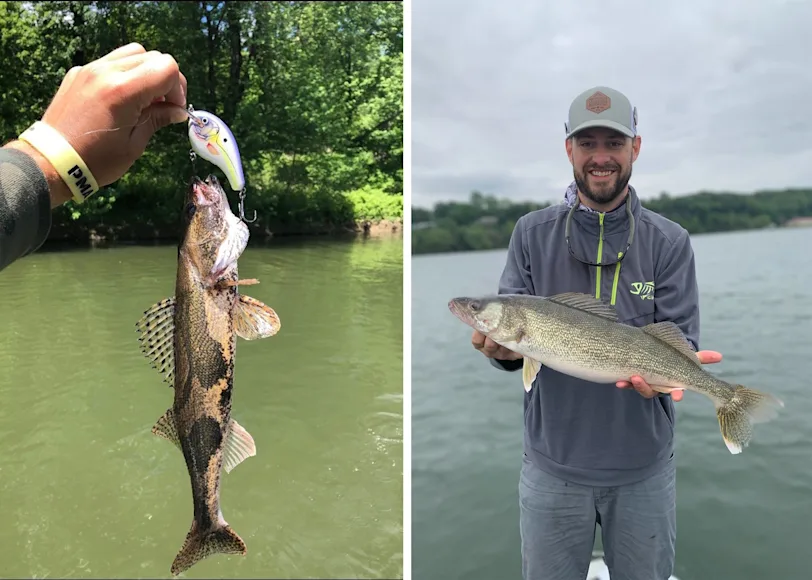We may earn revenue from the products available on this page and participate in affiliate programs. Learn more ›
Walleyes and saugers (and hybrid saugeyes, too) are fantastic game fish, widely distributed, excellent on the table, and, with few exceptions, reasonably eager to inhale a wide variety of live baits, plastics, and hard artificials. But how do you tell which one you’ve just caught? How do you tell a sauger vs walleye? Both fish share the same scientific family, Percidae, and at first glance they do appear to be quite similar. But look a little closer, and you’ll see the differences—some subtle and others quite obvious—that you can use to tell the two species apart.
There are visual differences, such as the walleye’s white-tipped tail fin, which absent on the sauger. Habitat, too, can be a good clue. Though found in river systems like the Mississippi, Missouri, and Columbia, walleyes often make still waters their home, showing a preference for clear cool waters and rock or gravel bottoms. Sauger, and the hybrid saugeye, on the other hand, tend to do well in faster-flowing turbid rivers, or in larger lakes featuring mud or sand bottoms.
There are those exceptions to every rule, of course. The Mississippi River at Guttenberg, Iowa (Pool 11), for instance, sees good populations of both species, with anglers often catching walleyes and sauger on consecutive drops. So, let’s break down the sauger vs walleye question in a little more detail.
Sauger vs Walleye: Physical Differences

Sauger on the left; walleye on the right. Derek Horner
Between the two species, the physical and visual differences aren’t many; however, they are pretty easy to spot. Here’s what to look for:
Size
Sauger are typically the smaller of the two, averaging 12 to 18 inches in length. Walleyes can stretch more than 30 inches or more, though fish in the 20- to 28-inch range are more the norm. The world-record sauger, taken in 1971 from Lake Sakakawea in North Dakota, weighed 8 pounds, 12 ounces; the world-record walleye, taken in 1960, was taken from Old Hickory Lake in Tennessee and weighed a mind-boggling 25 pounds, 4 ounces and measured 41 inches. In terms of shape, walleyes are more fat and pudgy, while saugers, true to their ‘cigar’ nickname, are typically skinny.
Coloration
Generally speaking, walleyes will be overall a beautiful golden color, free of blotches, while sauger will be darker—some refer to it as a ‘brass’ color—and will sport dark blotches from head to tail. This is a basic rule of thumb, however, as stained water can darken all species, walleyes included.
Markings
If you see a white tail tip, it’s a walleye. No white tip, it’s a sauger. Also, the sauger’s very spiny dorsal fin will show distinct circular spots; the walleye’s equally sharp dorsal fin will be just uniformly grayer than the body with a couple of darker bars often visible at the rear of the fin, with no obvious spots. A final identifier is the walleye’s smooth (scale-free or few scales) cheek in contrast to the sauger’s rough gill plates.
Sauger vs. Walleye: Habitat and Behavior
Both species are nomadic, structure-oriented predators, feeding on essentially any fish smaller than themselves. Walleyes tend to show a preference for deeper, cool water, especially as summer temperatures climb. Saugers tolerate a bit warmer water and will relate to soft bottoms, such as mud or sand, more-so than will the rock-loving walleyes.
In current, both species will position just inside the seam at the point where the water velocity drops, so that the flow delivers struggling prey, such as shad, chubs, or smolts, directly to them. As for willingness to bite, the sauger has a reputation as the somewhat more aggressive feeder, compared to the often-fickle walleye, which earn the former the moniker “the bluegill of the Family Percidae.”
How to Catch Saugers and Walleyes

The Bomber Long A (left) and Cotton Cordell Wally Diver are highly effective hard baits for both species. Bass Pro Shops
The top baits and lures for catching walleyes
will also catch saugers, and vice versa. For both species, it’s a toss-up between live bait rigs and jigs, either with bait or plastics, in terms of which one works the best. Night crawlers and minnows are top choices for baits, while 3- to 4-inch Twister Tail grubs
in chartreuse, white, yellow, or flake/sparkle will all catch both species.
Jigs and bait aren’t the only offerings that attract the cousins. Hardbaits, such as the classic Bomber Long A
or Cotton Cordell’s Wally Diver
, can be cast and retrieved from shore, trolled, or run in current on a 3-way rig, all with an equal likelihood of success. Other classic tactics—a gig minnow or leech under a slip bobber, or ripping blade baits over structure—work well for both. The truth is, when it comes to actually catching a sauger vs walleye, with all due respect to the late Dan Fogelberg and Tim Weisberg, they’re definitely “twin sons of different mothers.”
Which Tastes Better, Sauger or Walleye?
Walleye fans claim that ‘eyes are better on the table. Sauger aficionados will say the opposite, stamping their vote for the supposedly sweeter-tasting non-walleye. Neither camp is right or wrong. Both are firm white-fleshed fish, regarded by just about everyone as an excellent culinary experience. When it comes to eating sauger vs walleye, the truth is that once the golden fillets hit the plate alongside a mound of home fries and a dollop of ‘slaw, few can tell the difference. It’s all good.


